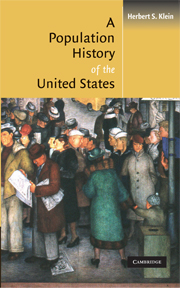Book contents
- Frontmatter
- Contents
- Graphs, Maps, and Tables
- Introduction
- 1 Paleo–Indians, Europeans, and the Settlement of America
- 2 Colonization and Settlement of North America
- 3 The Early Republic to 1860
- 4 The Creation of an Industrial and Urban Society, 1860–1914
- 5 The Evolution of a Modern Population, 1914–1945
- 6 The Baby Boom and Changing Family Values, 1945–1980
- 7 A Modern Industrial Society, 1980–2003
- Appendix: Tables, Graphs, and Maps
- Bibliography
- Index
7 - A Modern Industrial Society, 1980–2003
Published online by Cambridge University Press: 05 June 2012
- Frontmatter
- Contents
- Graphs, Maps, and Tables
- Introduction
- 1 Paleo–Indians, Europeans, and the Settlement of America
- 2 Colonization and Settlement of North America
- 3 The Early Republic to 1860
- 4 The Creation of an Industrial and Urban Society, 1860–1914
- 5 The Evolution of a Modern Population, 1914–1945
- 6 The Baby Boom and Changing Family Values, 1945–1980
- 7 A Modern Industrial Society, 1980–2003
- Appendix: Tables, Graphs, and Maps
- Bibliography
- Index
Summary
The patterns that had been evolving in the late 1960s and early 1980s came fully to fruition in the post–1980 period. Fertility and mortality – with some exceptions – continued to decline at the same rate as in the 1980s and the immigration movement increased in tempo, with the new immigration from Latin America and Asia continuing to dominate the flow. But there also began to appear in this period significant and unexpected changes in the traditional household and family organization. The trends of increasing illegitimate births, increasing importance of female-headed households, and higher ratios of adults living alone, which had previously appeared as the deviant behavior of the black minority, now began to appear with increasing frequency in the white majority. Although the reasons may have been different for these changes, the resulting trends and changes in household and marriage organization looked quite similar. For example, for all ethnic groups and races, ratios of birth outside marriage began to climb, female-headed households with children increased with each census and survey, and the number of persons living alone in single person households was on the increase. In fact, these patterns were to appear in all advanced industrial societies at this time and probably emerged in the United States for the same reasons. Changing roles for women in society, especially their advancement into high-status professional jobs as well as entrance into the workforce, the high cost of having children, and basic changes in ideas about contraception and premarital sex all led to a fundamental shift in opinions and then in performance.
- Type
- Chapter
- Information
- A Population History of the United States , pp. 207 - 238Publisher: Cambridge University PressPrint publication year: 2004



